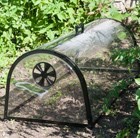|
Raspberries top the ‘easy-peasy’ list, especially if you opt for an autumn-fruiting variety that crops from late August or early September onwards. Cooler temperatures and shorter days suit the raspberry so autumn varieties are bountiful, self-supporting croppers. No staking is necessary for these. Pruning is easy too and for best results all the canes should be cut down to the ground in the second half of winter. February is most usual. Canes need to be planted 45cm apart with 2m between the rows, so you will need some space for a full double row. You can also grow a cluster of say seven canes, if space is tight. Whichever you choose, you will need a bright situation to attract the necessary pollinators.
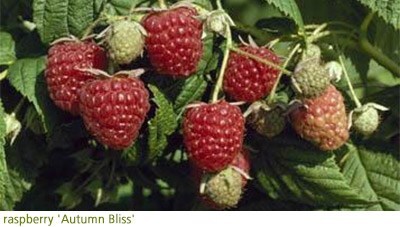
Good autumn-fruiting varieties include the first ever ‘Autumn Bliss’, bred at East Malling in 1984, and it’s still considered the benchmark variety. ‘Polka’ is also an autumn variety, although you can leave half the canes up in February and only cut away half to produce two smaller crops per year. The pointed fruits are larger and lighter in colour than ‘Autumn Bliss’, but size isn’t everything when it comes to fruit as while the individual fruits may be larger, the overall yield is generally less.
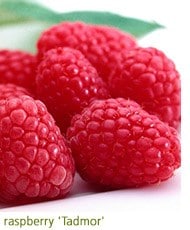 Summer raspberries, which generally begin in July, will need to be grown on supports. The Canadian-bred ‘Tulameen’ is excellent producing lots of fruit on long stems that can easily be picked. It follows on from the strawberry crop. The Scottish-bred ’Glen Ample’ also produces heavy yields. There’s also a new variety raised in New Zealand named ‘Tadmor’, designed to fill the gap between the summer and autumn varieties. If space allows, select three to four varieties and you can have four months of raspberries. Summer raspberries, which generally begin in July, will need to be grown on supports. The Canadian-bred ‘Tulameen’ is excellent producing lots of fruit on long stems that can easily be picked. It follows on from the strawberry crop. The Scottish-bred ’Glen Ample’ also produces heavy yields. There’s also a new variety raised in New Zealand named ‘Tadmor’, designed to fill the gap between the summer and autumn varieties. If space allows, select three to four varieties and you can have four months of raspberries.
Almost as easy are gooseberries, although they are the Marmite of the fruit world. You either love them or hate them. The green-berried ‘Invicta’ is high-yielding although extremely prickly so do site it carefully. It’s designed to be cooked and few summer puddings are as delicious as gooseberry fool. It’s not a good dessert variety, but it is resistant to American Gooseberry Mildew so does well in drier gardens where mildew is more likely to strike. Green varieties can also tolerate shade.
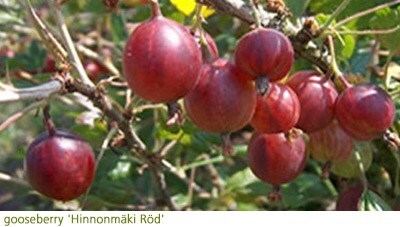
The pink or red-berried gooseberries are delicious to eat when the berries plump up, although you may have to keep the blackbirds (and the children) away with netting or threats. ‘Hinnonmaki Red’ is hardy, disease resistant and crops better than other reds so this is the one to go for. The red berries are highly ornamental so this variety is ideal in smaller gardens.

Strawberries demand a little more skill, although the sun-warmed strawberry picked fresh is as different as chalk and cheese when compared to a cold-stored supermarket strawberry. Varieties come in two forms, the everbearer and the summer fruiter. Everbearers, crop over many months but tend to be less strawberry flavoured owing to the alpine strawberry influence in their breeding. They produce very few or no runners and the fruit tends to be smaller. However if you want to nibble throughout summer, or have red fruits on show over months, try ‘Buddy’ a new everbearer released by East Malling in 2012. It has a truer strawberry flavour than the others.
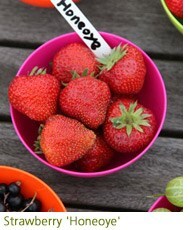 If you want to eat home-grown strawberries in Wimbledon week opt for ‘Honeoye’, an early heavy-cropping variety with shiny berries with a sweet flavour. ‘Fenella’ (East Malling 2010) will give you a later crop of orange-red berries in mid-July. These are both summer-fruiting and all the leaves should be cut back to nothing after fruiting finishes. Feeding with a high potash food produces more berries and you must have a frost-free place because strawberry flowers are blackened at the merest hint of frost. In colder gardens, opt for a late variety if there’s only space for one. Netting is essential: we are dealing with the scrummiest fruit of all. If you want to eat home-grown strawberries in Wimbledon week opt for ‘Honeoye’, an early heavy-cropping variety with shiny berries with a sweet flavour. ‘Fenella’ (East Malling 2010) will give you a later crop of orange-red berries in mid-July. These are both summer-fruiting and all the leaves should be cut back to nothing after fruiting finishes. Feeding with a high potash food produces more berries and you must have a frost-free place because strawberry flowers are blackened at the merest hint of frost. In colder gardens, opt for a late variety if there’s only space for one. Netting is essential: we are dealing with the scrummiest fruit of all.
The perfect mixer for strawberries in a stewed fruit compote, is rhubarb and John's 3 Colours Red Rhubarb Collection will provide you with ‘Timperley Early’ (which can be forced once established), the red-stemmed ‘Raspberry Red’ and ‘Victoria’ - an old juicy variety with green stems. Not technically fruit, more of an honorary one, rhubarb prefers moist soil and a cool place because it originally came from the river banks of the River Volga.
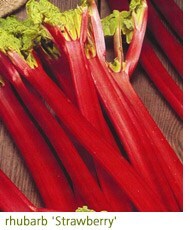 Rhubarb was used a medicine and at one time England was spending a small fortune importing it from China. The government were so concerned about the amount of money leaving British shores that in 1763 The London Society for the Encouragement of the Arts, Manufactures and Commerce offered a Gold Medal to the person who could raise the most plants. Many tried but the medal was given to Sir William Fordyce, who raised 300 plants in Dorset. Now everyone has a rhubarb plant! Rhubarb was used a medicine and at one time England was spending a small fortune importing it from China. The government were so concerned about the amount of money leaving British shores that in 1763 The London Society for the Encouragement of the Arts, Manufactures and Commerce offered a Gold Medal to the person who could raise the most plants. Many tried but the medal was given to Sir William Fordyce, who raised 300 plants in Dorset. Now everyone has a rhubarb plant!
Blackberries are enjoying a revival because there’s so much new breeding, especially in America where this berry reigns supreme. ‘Reuben’ is a new, upright American variety that fruits on this year’s wood. All the wood should be cut away in the second half of winter to encourage vigorous growth in the following spring. Once the canes have developed, tip them back by a couple of inches to promote the side shoots. This is a good tip with all cane fruits.
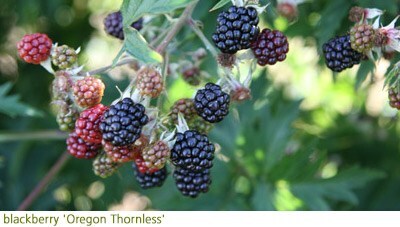
Most traditional varieties fruit on one year old wood, so the old blackberry canes are cut away after fruiting to leave the new ones to flourish. Traditional blackberries treated in this way include the Scottish-bred ‘Loch Ness’, which crops heavily in mid-August for roughly four weeks. It’s also not thorny. Blackberries can be wall-trained on the sunny side of a shed or outbuilding so they can take up little space. ‘Ouachita', an American-bred variety with huge berries, has firm yet extremely tasty fruits. It is more upright than many. ‘Oregon Thornless’ combines divided, ornate foliage with a modest number of berries so it is often trained onto a pergola with roses and clematis. They all need rigid supports they can be tied onto.
Bramble flowers sustain lots of pollinators and the fruit of modern varieties is sweet enough to eat raw. It also looks luscious. Although bombproof once established and not that fussy about where they grow, blackberries can be tricky to get going and they will not thrive on wet soil, so it’s worth preparing the ground well before you plant. Add garden compost, or loam-based compost mixed with grit to improve the drainage in the early stages. Once established they are fine, but blackberries will fail on sticky clay unless you improve it.

Currants also provide bountiful crops, but redcurrants and blackcurrants vary in their preferences. Blackcurrants enjoy warm, damp conditions and most of the crops used in a well known cordial are grown in Herefordshire where rainfall is abundant. So if you have reasonable amounts of rainfall go for these. They are also more useful in the kitchen than redcurrants because they can be cooked or preserved. They flower early though and if these are caught by a frost it may reduce the crop, so site them on the top of a slope or in another frost-free place.
 Pruning is simple. The new growth comes from the base so, once your bush is established, remove a third of the oldest wood from the base. This will look darker than the new wood. Good varieties include ‘Big Ben’ a bush with huge berries that are sweet enough to eat fresh, or 'Ben Sarek' another big-berried variety that flowers later. The latter is the best variety for colder gardens where frost often strikes in late-spring as it shows some in-bred frost resistance. It is also more compact than many varieties, so more suited to a smaller garden. Pruning is simple. The new growth comes from the base so, once your bush is established, remove a third of the oldest wood from the base. This will look darker than the new wood. Good varieties include ‘Big Ben’ a bush with huge berries that are sweet enough to eat fresh, or 'Ben Sarek' another big-berried variety that flowers later. The latter is the best variety for colder gardens where frost often strikes in late-spring as it shows some in-bred frost resistance. It is also more compact than many varieties, so more suited to a smaller garden.
If you have a dry garden opt for a redcurrant bush because these thrive in drier, warmer gardens. The pruning regime is different. Prune as you would with gooseberries, by shortening the laterals (the side shoots) after picking. Then winter prune by removing the 3Ds (the dead, dying and diseased) and then thinning out the wood to create an airy shape. Finally reduce the length of the main uprights by one third. ‘Laxton’s No 1’ is a heavy cropper. They’re good to eat raw with peaches etc, good for garnishing and they make the greatest jelly of all - especially with lamb.

Blueberries are acid-soil plants so most of us have to grow them in large containers full of ericaceous compost. It’s worth persevering for blueberries can be picked every few days, little and often, and they are delicious eaten straight away. ‘Chandler’ has berries that are twice the size of the others, quite late in the season. ‘Bluecrop’ produces lots of smaller but equally delicious fruits in mid-season and ‘Duke’ produces early berries. With planning it’s possible to have seven weeks of berries from these, once established. Blueberries are self fertile but they will produce a bigger crop if their flowers are cross pollinated, so grow more than one variety if you can - preferably in a frost-free position as their flowers are produced early on. It’s a superfood, full of antioxidants, but eating fresh fruit you’ve grown is also sheer pleasure!
| 


























